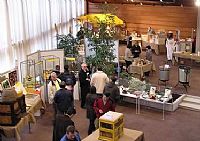 6th international sales exhibition of bee-keeping equipment, products and conference at Pazin, Spomen dom (Memorial centre).
6th international sales exhibition of bee-keeping equipment, products and conference at Pazin, Spomen dom (Memorial centre).
In Istria it all begins in April when beekeepers harvest fruit honey and dandelion honey which is extracted until May. Then the hives and beekeepers, like real nomads, move in search of locust trees that yield high quality and delicious honey. At the same time bees are diligently collecting sage nectar. The next activity takes place in June when hives are transferred to areas rich in chestnut trees, which has become a very uncertain and modest source of honey. At this period there is no activity of bees in Istria, so the search for flower blossoms for the nectar takes beekeepers to areas of Gorski kotar, Kordun and Lika. This best speaks of the beekeepers' nomadic way of life and their readiness to cover several hundred kilometres every seven days to reach the faraway hives just for a few kilograms of sweet honey. In mid-September the bees return home. Then they mostly sip the nectar from heather and other plants blossoming at that time. For those who don't know much about honey making and its terminology, honey extraction is the process of removing honey from the honeycomb. So, after the last honey extraction in the year, beekeepers prepare their bees for the winter, leaving enough honey for them to survive - about fifteen kilograms in each hive.